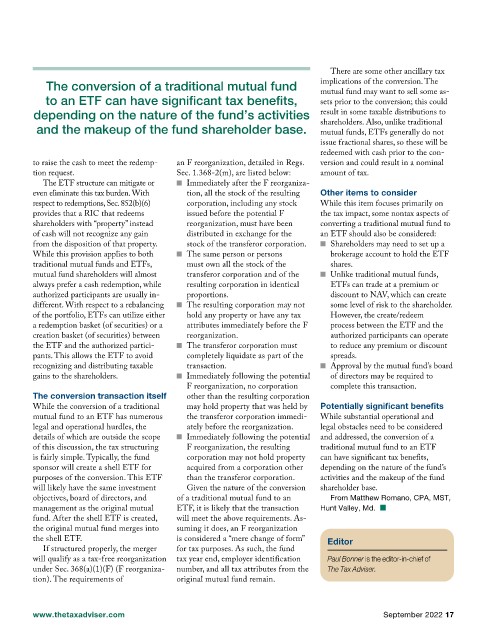Page 457 - TaxAdviser_2022
P. 457
There are some other ancillary tax
The conversion of a traditional mutual fund implications of the conversion. The
mutual fund may want to sell some as-
to an ETF can have significant tax benefits, sets prior to the conversion; this could
depending on the nature of the fund’s activities result in some taxable distributions to
and the makeup of the fund shareholder base. shareholders. Also, unlike traditional
mutual funds, ETFs generally do not
issue fractional shares, so these will be
redeemed with cash prior to the con-
to raise the cash to meet the redemp- an F reorganization, detailed in Regs. version and could result in a nominal
tion request. Sec. 1.368-2(m), are listed below: amount of tax.
The ETF structure can mitigate or ■ Immediately after the F reorganiza-
even eliminate this tax burden. With tion, all the stock of the resulting Other items to consider
respect to redemptions, Sec. 852(b)(6) corporation, including any stock While this item focuses primarily on
provides that a RIC that redeems issued before the potential F the tax impact, some nontax aspects of
shareholders with “property” instead reorganization, must have been converting a traditional mutual fund to
of cash will not recognize any gain distributed in exchange for the an ETF should also be considered:
from the disposition of that property. stock of the transferor corporation. ■ Shareholders may need to set up a
While this provision applies to both ■ The same person or persons brokerage account to hold the ETF
traditional mutual funds and ETFs, must own all the stock of the shares.
mutual fund shareholders will almost transferor corporation and of the ■ Unlike traditional mutual funds,
always prefer a cash redemption, while resulting corporation in identical ETFs can trade at a premium or
authorized participants are usually in- proportions. discount to NAV, which can create
different. With respect to a rebalancing ■ The resulting corporation may not some level of risk to the shareholder.
of the portfolio, ETFs can utilize either hold any property or have any tax However, the create/redeem
a redemption basket (of securities) or a attributes immediately before the F process between the ETF and the
creation basket (of securities) between reorganization. authorized participants can operate
the ETF and the authorized partici- ■ The transferor corporation must to reduce any premium or discount
pants. This allows the ETF to avoid completely liquidate as part of the spreads.
recognizing and distributing taxable transaction. ■ Approval by the mutual fund’s board
gains to the shareholders. ■ Immediately following the potential of directors may be required to
F reorganization, no corporation complete this transaction.
The conversion transaction itself other than the resulting corporation
While the conversion of a traditional may hold property that was held by Potentially significant benefits
mutual fund to an ETF has numerous the transferor corporation immedi- While substantial operational and
legal and operational hurdles, the ately before the reorganization. legal obstacles need to be considered
details of which are outside the scope ■ Immediately following the potential and addressed, the conversion of a
of this discussion, the tax structuring F reorganization, the resulting traditional mutual fund to an ETF
is fairly simple. Typically, the fund corporation may not hold property can have significant tax benefits,
sponsor will create a shell ETF for acquired from a corporation other depending on the nature of the fund’s
purposes of the conversion. This ETF than the transferor corporation. activities and the makeup of the fund
will likely have the same investment Given the nature of the conversion shareholder base.
objectives, board of directors, and of a traditional mutual fund to an From Matthew Romano, CPA, MST,
management as the original mutual ETF, it is likely that the transaction Hunt Valley, Md. ■
fund. After the shell ETF is created, will meet the above requirements. As-
the original mutual fund merges into suming it does, an F reorganization
the shell ETF. is considered a “mere change of form” Editor
If structured properly, the merger for tax purposes. As such, the fund
will qualify as a tax-free reorganization tax year end, employer identification Paul Bonner is the editor-in-chief of
under Sec. 368(a)(1)(F) (F reorganiza- number, and all tax attributes from the The Tax Adviser.
tion). The requirements of original mutual fund remain.
www.thetaxadviser.com September 2022 17

